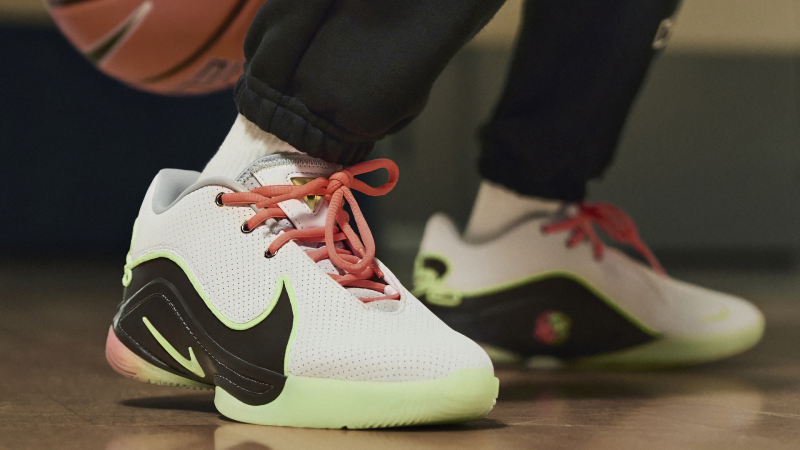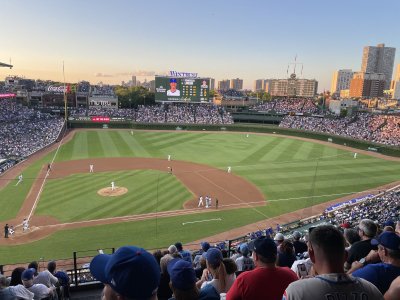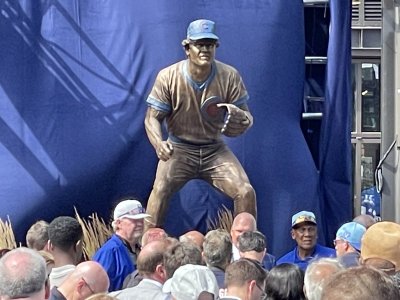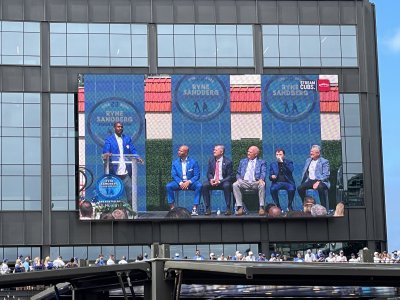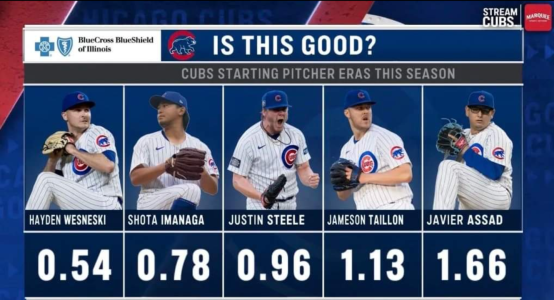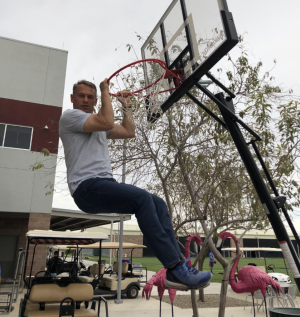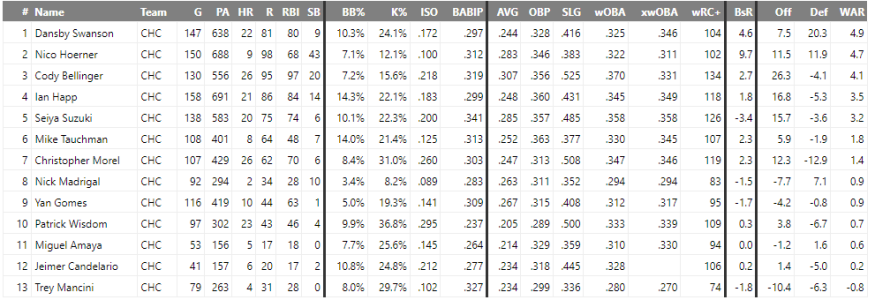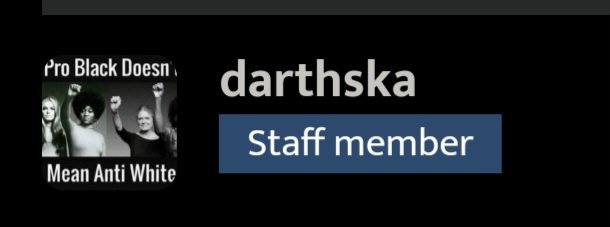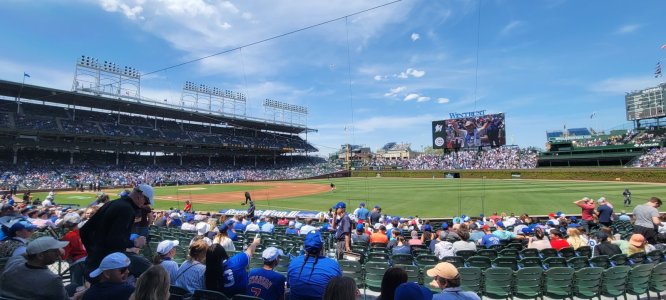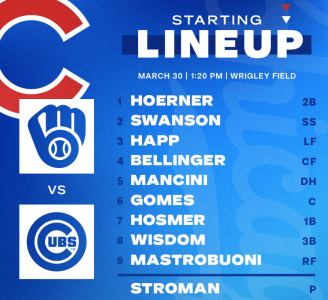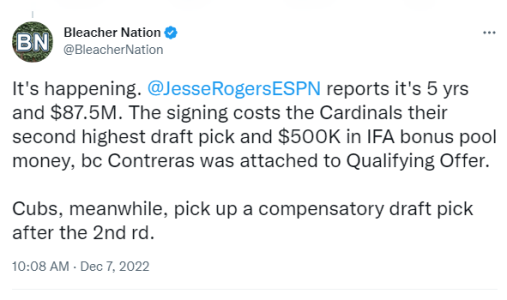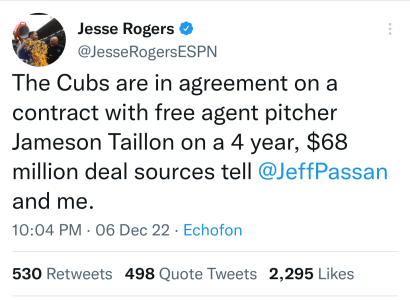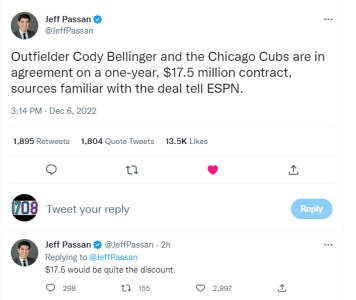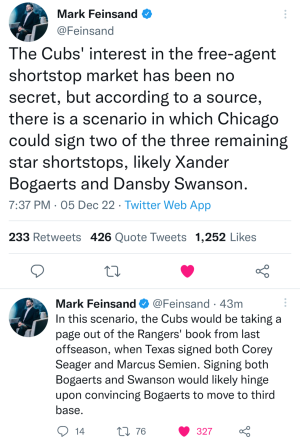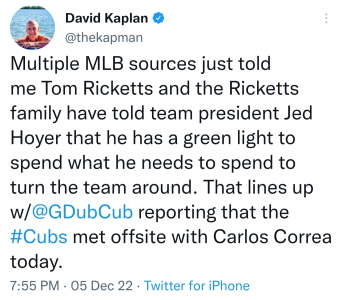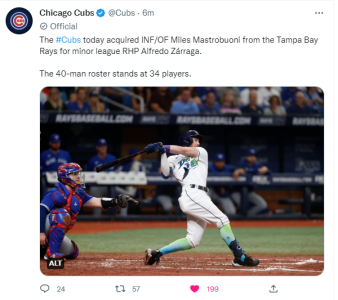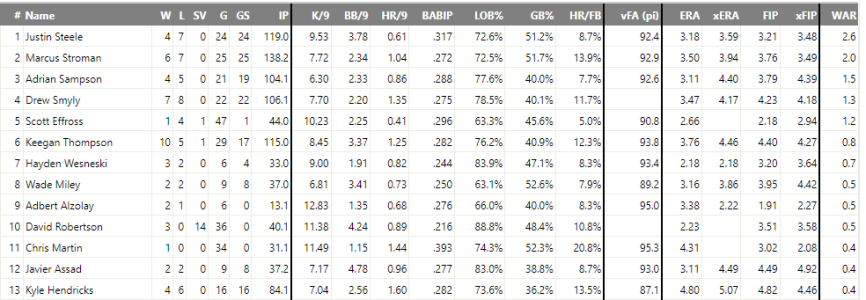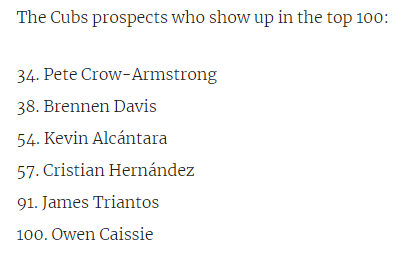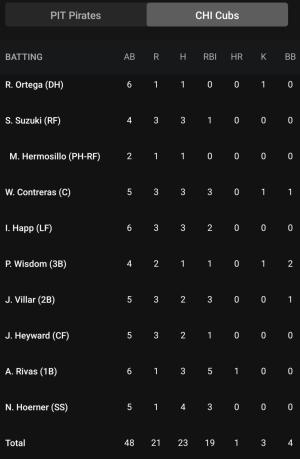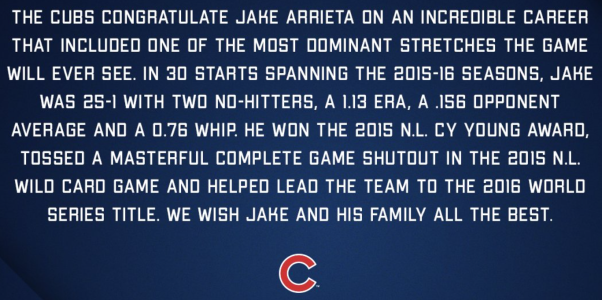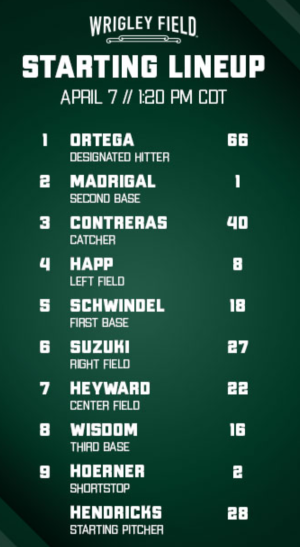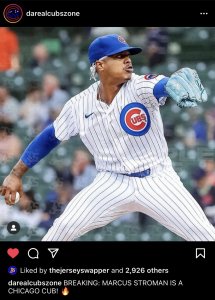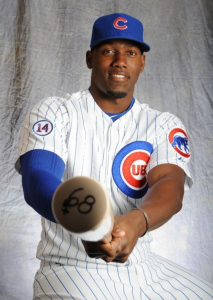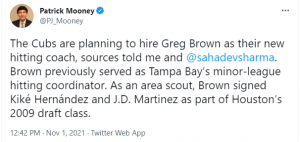One of the things that makes it such a joy to watch the Chicago Cubs’ rebuilding plan unfold is that the team’s approach is completely transparent. There’s no trickery here, no deceit, no super-secret process that’s inscrutable to everyone outside of the front office.
I don’t simply mean that the Cubs are rebuilding with complete conviction; under the terms of MLB’s collective bargaining agreement, that’s really the only way to go.1 Nor do I mean that the Cubs are nearly the extremists that the Houston Astros are. I’m referring instead to the core principle with which the Cubs have been trying to build a championship roster since team president Theo Epstein and general manager Jed Hoyer were hired after the 2011 season, a principle that distinguishes this rebuilding project from almost every other one in baseball history: They’re building an offense from within and a pitching staff from spare parts.
This flies in the face of more than a century of conventional baseball wisdom, which states that (1) pitching wins championships, and (2) a team can never have too much pitching. The Cubs’ approach is completely counterintuitive. It’s also completely right.
It may be true that it’s difficult to reach the playoffs without an elite pitching staff. (It’s equally hard to reach the playoffs without an elite offense, but never mind.) It may even be true that good pitching beats good hitting in the playoffs, although the evidence to support that is surprisingly sketchy. But the sport’s pitching obsession has one fatal flaw: Pitchers aren’t reliable. Young pitchers get hurt, and fail to develop, and lose the strike zone overnight. Trying to build around young pitching is like trying to hold water in your hands: It’s impossible to keep some of it from leaking out over time. The more resources a team invests in it, the more resources the team will squander. It’s a fundamental law of the sport.
Rather than accept this attrition as the cost of doing business, the Cubs are trying a different way, which involves two simple principles:
1. Investing a preponderance of their draft-and-development resources on hitting.
2. Taking advantage of the unpredictability of pitchers by cheaply acquiring established major league pitchers with upside.
Regarding the first point: Here’s a list of the Cubs’ last four first-round picks, all selected in the top 10:
2011: Javier Baez (no. 9 overall)
2012: Albert Almora (no. 6 overall)
2013: Kris Bryant (no. 2 overall)
2014: Kyle Schwarber (no. 4 overall)
In 2013, when the Cubs had the no. 2 overall pick, the industry consensus was that the two best players available were Mark Appel and Jonathan Gray, both college pitchers. It’s hard to believe now, but the Cubs’ decision to pick Bryant raised some eyebrows at the time. The Cubs wagered on the side of history, which has shown that truly elite collegiate hitters — the kind you see once a year in the draft, if that — almost always turn into at least average major league players, usually becoming stars. And sure enough, Bryant has put up video-game numbers all season, hitting .355/.458/.702 in Double-A and .315/.430/.657 in Triple-A and mashing 38 homers between both stops; he might be the best prospect in baseball right now. Meanwhile, Appel, whom the Astros took with the no. 1 pick, posted a 9.74 ERA in high-A ball earlier this year.
In the 2014 draft, the Cubs picked fourth, and the first three picks were all pitchers. So the Cubs once again zagged, picking Kyle Schwarber, a catcher from Indiana University who most teams saw as a mid–first round talent because he didn’t profile as a catcher defensively. The Cubs focused on his bat and decided they’d figure out his position later. Schwarber has played more left field than catcher in his short pro career; he’s also hit .335/.441/.584 in 52 games and has been promoted twice.
Throw in the $30 million contract the Cubs gave Cuban defector Jorge Soler two years ago, and the five prospects in whom the Cubs have invested the most are all hitters.
The offense-heavy tilt to the Cubs’ farm system has been apparent for more than a year now, and observers keep waiting for the Cubs to switch gears and go after pitching. Instead, the team keeps doubling down on bats. The Cubs have traded away significant major league talent twice in the past year, and both times it was to acquire more young hitters. Five weeks ago, Chicago traded Jeff Samardzija and Jason Hammel to the Oakland A’s, and in return it got Addison Russell, a 20-year-old shortstop who’s one of the 10 best prospects in baseball, and Billy McKinney, an outfielder who was the Athletics’ first-round pick in 2013. And at the trading deadline, the Cubs packaged Emilio Bonifacio and James Russell to Atlanta in exchange for Victor Caratini, a switch-hitting catcher with on-base skills.
Prior to calling up Baez last week and Arismendy Alcantara last month, the Cubs had arguably the best farm system in baseball, and according to MLB.com, their top six prospects, and 12 of their top 15, were hitters. It’s been a long time since any team had so many hitting prospects in its organization at once.
The flip side is that while the Cubs are taking care of business on the farm when it comes to hitters, there aren’t a lot of arms down there. Naturally, given the slew of pitcher injuries that have cast a pall over this season, the best of those arms, C.J. Edwards, missed much of the season’s first half with a sore shoulder. Yet that’s where the second prong of the Cubs’ strategy comes in: They don’t have to develop young pitchers and assume the risk of failure when they can instead acquire other teams’ “failed” young pitchers at pennies on the dollar.
I put “failed” in scare quotes because the pitchers Chicago acquires haven’t really failed at all — they’ve simply suffered bad luck. Since Voros McCracken’s seminal breakthrough on defense-independent pitching stats in 2001 — arguably the most significant finding in sabermetric history — no team has put his work to better use than the Epstein/Hoyer Cubs.
The central thesis of McCracken’s findings was that pitchers really only have control over three things: walks, strikeouts, and home runs. By extension, they have a minimal ability to control what happens on balls in play, which is the province of their defense. The obvious inference from this is that it’s better to evaluate pitchers based on the three things they control than on the number of runs they allow. Hence the stat FIP (fielding independent pitching), which estimates a pitcher’s ERA based on the number of walks, strikeouts, and home runs he allows.
There are other stats that measure the same thing — xFIP, SIERA, Nate Silver’s Quick ERA — but for simplicity’s sake we’ll stick with FIP. The key point with all of these stats is this: They predict what a pitcher’s ERA will be next year far better than his actual ERA does. If a team is considering two pitchers, one of whom has a 3.00 ERA but a 4.50 FIP, and one of whom has a 4.50 ERA and a 3.00 FIP, it should bet on the latter pitcher every time.
The Cubs have been betting on the latter pitcher for the last three years, which is wise for two reasons: Not only is that pitcher more likely to succeed in the future, he’s also usually available for next to nothing. More than a decade after Moneyball and the sabermetric revolution, and even though every team in baseball pays at least lip service to the idea of analytics,2 plenty of franchises still haven’t absorbed the core principle of defense-independent theory. That negligence elsewhere has given the Cubs free reign to pick up pitchers whose ERA vastly understates their true ability. For instance:
• After the 2011 season, they got Travis Wood, who had a 4.84 ERA that year but a 4.06 FIP, as one of three players in a trade for left-handed reliever Sean Marshall. In 2012, Wood had a 4.27 ERA, and in 2013 he had a 3.11 ERA in 200 innings and made the All-Star team.
• After the 2012 season, they signed Scott Feldman, a free agent who had posted a 5.09 ERA but a 3.81 FIP, to a modest one-year, $6 million contract. In 15 starts for the Cubs in 2013, Feldman had a 3.46 ERA, making him a prized commodity at the trade deadline and enabling the Cubs to flip him to Baltimore for reliever Pedro Strop and …
• … Jake Arrieta, a former two-time Top 100 prospect who had a 6.20 ERA but a 4.05 FIP in 2012, and a 7.23 ERA but a 4.61 FIP in five 2013 starts before the Orioles sent him to the minors. Arrieta made nine starts for the Cubs last year after the trade, cutting his season ERA to 3.66 even though his FIP rose slightly to 4.94. That set the stage for this year, when Arrieta has been arguably the breakout pitcher of 2014, posting a 2.77 ERA and an astounding 2.37 FIP.
• To fill Feldman’s vacated role as the veteran free agent signed to a one-year deal and destined to be flipped for prospects in July, the Cubs signed Hammel last winter — to the same $6 million salary. Hammel’s career ERA of 4.80 was much higher than his career FIP of 4.33, and he’d spent his entire career pitching either in the tinderbox that is the AL East (for Tampa Bay and Baltimore) or for the Rockies in Coors Field. Hammel made 17 starts for the Cubs this year, pitching to the tune of a 3.19 FIP and 2.98 ERA, and the Cubs were able to package him with Samardzija to get one of the best prospects in the game.
Not every pitcher the Cubs have tried this with has panned out, of course: Chris Volstad, who was cut from the same cloth, washed out of Chicago. And while many pitchers began to perform like their FIPs indicated they would, other pitchers have genuinely improved after arriving in Chicago and working with pitching coach Chris Bosio. Yet four times the Cubs acquired a pitcher whom simple sabermetric analysis said was performing better than the results showed, and four times they were rewarded with a pitcher whose ERA quickly fell in line with his peripheral stats.
Which brings us to last week, and the Cubs’ Kevin Millar moment. As a corner outfielder for the Florida Marlins, Millar had batted .306/.366/.509 in 2002 and .314/.374/.557 in 2001. Even by the inflated offensive standards of that era, Millar could hit. Yet the Marlins, for reasons that remain unclear, decided they didn’t want him. Not only that — they convinced Millar that no team wanted him. Millar agreed to go play in Japan in 2003, and the Marlins put him on waivers, a mere formality, since what American team could possibly want an everyday player who had hit .300 and slugged .500 each of the last two years?
Well, it turned out that Epstein and Hoyer wanted Millar in Boston. The Red Sox claimed him off waivers, worked out a deal to buy him from the Marlins, and made him their primary first baseman. He was still their primary first baseman when they won the World Series a year later.
Last Tuesday, the Marlins sent Epstein and Hoyer another gift. They designated Jacob Turner for assignment, presumably because Turner had a 5.97 ERA in 78 innings — but his 54 strikeouts, 23 walks, and eight homers allowed were good for a 4.00 FIP. The Marlins had served up the Cubs’ ideal pitching project on a tee. Turner was so obviously in the Cubs’ wheelhouse that I tweeted this:
Regardless that Turner was pitching better than his ERA suggested, Miami’s willingness to flat-out cut him is baffling. Just last year, Turner posted a 3.74 ERA in 118 innings for the Marlins, despite a higher FIP (4.43) than this year’s. Just two years ago, Turner was the key prospect the Marlins acquired from the Detroit Tigers in exchange for Anibal Sanchez and Omar Infante. After Turner was selected ninth overall in the 2009 draft, both Baseball America and Baseball Prospectus ranked him as one of the top-30 prospects in baseball in 2010, 2011, and 2012.
Four months ago, the Marlins could have gotten a huge haul of talent for Turner, yet they cut him even though he was pitching better than ever. Turner’s FIP this year is the best of his career. His average fastball velocity (92.6 mph) is the highest of his career. Releasing him defies explanation. If you were to put together a list of the pitchers most likely to be the Arrieta of 2015, Turner might rank at the very top. I’m sure the Marlins had their reasons for getting rid of him, but then I’m sure they had their reasons for getting rid of Millar 11 years ago.
Really, the only reason to think Turner would not wind up in Chicago was that the Cubs didn’t have first crack at him. They were second on the waiver wire behind the Colorado Rockies, and all the Rockies had to do was put in a waiver claim. But they didn’t, possibly because the Rockies are so rich in pitching that they just don’t have the room for him, or possibly because they’re a completely clueless organization that doesn’t know what the hell it’s doing. On Wednesday, the Cubs were awarded the waiver claim on Turner. On Friday, they sent a couple of fringe prospects to Miami to officially consummate the deal, and for their troubles they have a 23-year-old former top prospect who won’t be a free agent until after the 2018 season.
Turner will work out of the Cubs’ bullpen for now, as they take their time unwrapping the present the Marlins sent them. And yes, it’s possible the Marlins know something the rest of us don’t and that Turner will be an ex-Cub before long. If so, well, they didn’t give up anything to get him in the first place.
But if it turns out that Turner, like Millar before him, was carelessly discarded by the Marlins, the rebuilding process at Wrigley Field will have moved one step closer to fruition. It’s quietly been a very good year for that process — and so good that even their most skeptical fans are starting to take note. Anthony Rizzo and Starlin Castro, the cornerstones of the offense, have bounced back in a big way; Alcantara arrived ahead of schedule; Baez hit the game-winning extra-inning homer in his first major league game, and two homers in a game two days later.
Bryant has an 1.129 OPS in the minors, and after missing most of the first two months with an injury, Soler has hit even better than Bryant, batting .369/.467/.758 this year while advancing to Triple-A. Russell has hit .308/.357/.556 in Double-A since being acquired. The Cubs also were awarded the waiver claim on Cole Hamels, and while they couldn’t work out a deal with the Phillies,3 that the Cubs were willing to take on Hamels’s hefty contract is a strong sign that they’ll be big players for a premium free-agent starting pitcher this winter.
If they do sign a Max Scherzer or a Jon Lester this offseason, the Cubs won’t just be a sexy pick to make the playoffs in 2015 — they might be a smart one. This franchise is a whole lot closer to being a contender than most people realize. And thanks to the Marlins, that’s even truer today than it was last week.
I think they're players for Scherzer. Pitching is the easy part.
I believe they're going to try and work out a multi-year deal since his deal for next year is only $500,000.





